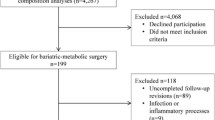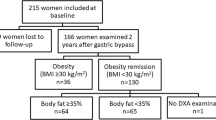Abstract
Background
In this study, we explored in a prospective cohort of morbidly obese women undergoing laparoscopic Roux-en-Y gastric bypass (LRYGP) correlations between baseline anthropometrics, metabolic parameters, resting energy expenditure (REE), body composition, and 1-year % excess body mass index loss (%EBMIL). We also investigated risk factors for insufficient %EBMIL.
Methods
One hundred three consecutive women were prospectively evaluated at baseline (age 40.6 ± 11.2, weight 113.9 kg ± 15.3, BMI 43.3 ± 4.9 kg/m2) and 1 year after LRYGP. Weight, excess weight, brachial circumference, waist circumference, fat mass (FM) and fat-free mass (FFM) (measured with bioelectrical impedance analysis), REE, inflammation, insulin resistance, and lipid disturbances were determined before and 1 year after LRYGP.
Results
At 1 year, mean weight loss was 39.8 kg ± 11.7 and mean EBMIL was 15.2 kg/m2 ± 4.2. Mean %EBMIL was 86% ± 21% (range 30–146%). Baseline brachial circumference, waist circumference and triceps skinfold thickness decreased significantly at 1 year (P < 0.001). Blood glucose and insulin levels, HDL cholesterol, LDL cholesterol, triglycerides, and CRP also decreased significantly (P < 0.001). The mean loss of initial FFM and FM was 9.1 kg ± 8.2 (15%) and 30.7 kg ± 11.8 (53%), respectively. REE on body weight ratio (REE/BW) increased from 15.3 kcal/kg ± 2.8 to 18.4 kcal/kg ± 2.5 (p < 0.0001) and REE on FFM ratio decreased from 31.2 to 28.7 kcal/day/kg (p < 0.001). Preoperative waist circumference (r = −0.3; P < 0.001), blood glucose level (r = −0.37; P < 0.001), and CRP (r = −0.28; P = 0.004) were negatively correlated with EBMIL% 1 year after surgery. Among baseline body composition parameters, only preoperative FM was negatively correlated with %EBMIL (r = −0.23; p = 0.02). One year after surgery FM change was negatively correlated with EBMIL% (r = −0.49; P < 0.001) while FFM/BW ratio was positively correlated with %EBMIL (r = 0.71; P < 0.001). Increase in REE/BW at 1 year was positively correlated with %EBMIL (r = 0.47; p < 0.001). On multivariate analysis, baseline blood glucose level (OR = 1.77; CI 95%: [1.3–2.4]) was the only predictive factor of EBMIL <60% at 1 year.
Conclusion
LRYGB has beneficial effects on clinical, biological parameters, and body composition. Increasing the proportion of FFM on total BW and REE/BW is associated with better results in terms of weight loss. Baseline glucose level may be helpful in identifying poor responders to LRYGBP.
Trial Registration




Similar content being viewed by others
Change history
05 July 2017
An erratum to this article has been published.
References
Hruby A, Hu FB. The epidemiology of obesity: a big picture. Pharmaco Economics. 2015 Jul;33(7):673–89.
Kim NH, Seo JA, Cho H, et al. Risk of development of diabetes and cardiovascular disease in metabolically healthy obese people: the Korean genome and epidemiology study. Medicine (Baltimore). 2016 Apr;95(15):e3384.
Bingol Z, Pıhtılı A, Cagatay P, et al. Clinical predictors of obesity hypoventilation syndrome in obese subject with SAS. Respir Care. 2015 May;60(5):666–72.
Carpentier AC. Hypertriglyceridemia associated with abdominal obesity: getting contributing factors into perspective. Arterioscler Thromb Vasc Biol. 2015 Oct;35(10):2076–8.
Nigatu YT, Reijneveld SA, De Jonge P, et al. The combined effects of obesity, abdominal obesity and major depression/anxiety on health-related quality of life: the LifeLines Cohort Study. PLoS One. 2016 Feb 11;11(2):e0148871.
Get W, Lewington S, Sherliker P, et al. Body-mass index and cause-specific mortality in 900 000 adults: collaborative analyses of 57 prospective studies. Lancet. 2009 Mar 28;373(9669):1083–96.
Berrington de Gonzalez A, Hartge P, Cerhan JR, et al. Body-mass index and mortality among 1.46 million white adults. N Engl J Med. 2010;363(23):2211–9.
Angrisani L, Santonicola A, Iovino P, et al. Bariatric surgery worldwide 2013. Obes Surg. 2015 Oct;25(10):1822–32.
Iannelli A, Dainese R, Piche T, et al. Laparoscopic sleeve gastrectomy for morbid obesity. World J Gastroenterol. 2008 Feb 14;14(6):821–7.
Maciejewski ML, Arterburn DE2, Van Scoyoc L3, Smith VA1, Yancy WS Jr et al. Bariatric surgery and long-term durability of weight loss. JAMA Surg. 2016 Nov 1; 151(11):1046–1055.
Sugerman HJ, Wolfe LG, Sica DA, et al. Diabetes and hypertension in severe obesity and effects of gastric bypass-induced weight loss. Ann Surg. 2003 Jun;237(6):751–6. discussion 757-8
Aminian A, Brethauer SA, Andalib A, et al. Can sleeve gastrectomy “cure” diabetes? Long-term metabolic effects of sleeve gastrectomy in patients with type 2 diabetes. Ann Surg. 2016 Oct;264(4):674–81.
Buchwald H, Estok R, Fahrbach K, Banel D, Jensen MD, Pories WJ et al. Weight and type 2 diabetes after bariatric surgery: systematic review and meta-analysis. Am J Med. 2009 Mar;122(3):248–256.e5.
Nicoletti CF, de Oliveira BA, de Pinhel MA, et al. Influence of excess weight loss and weight regain on biochemical indicators during a 4-year follow-up after Roux-en-Y gastric bypass. Obes Surg. 2015 Feb;25(2):279–84.
Sallet PC, Sallet JA, Dixon JB, et al. Eating behaviors as a prognostic factor for weight loss after gastric by pass. Obes Surg. 2007 Apr;17(4):445–51.
Sjostrom L, Lindroos AK, Peltonen M, et al. Lifestyle, diabetes, and cardiovascular risk factors 10 years after bariatric surgery. N Engl J Med. 2004 Dec 23;351(26):2683–93.
Warde-Kamar J, Rogers M, Flancbaum L, et al. Caloric intake and meal patterns up to 4 years after RYGB surgery. Obes Surg. 2004 Sep;14(8):1070–9.
Christou NV, Look D, Maclean LD. Weight regain after short and long limb gastric by-pass in patients followed for longer than 10 years. Ann Surg. 2006 Nov;244(5):734–40.
Meguid MM, Glade MJ, Middleton FA. Weight regain after RYGB: as significant 20% complication related to PYY. Nutrition. 2008 Sep;24(9):832–42.
Carneiro IP, Elliott SA, Siervo M, et al. Is obesity associated with altered energy expenditure? Adv Nutr. 2016 May 16;7(3):476–87.
Carrasco F, Papapietro K, Csendes A, et al. Changes in REE and body composition after weight loss following Roux-en-Y gastric bypass. Obes Surg. 2007 May;17(5):608–16.
Tam CS, Redman LM, Greenway F, et al. Energy metabolic adaptation and cardiometabolic improvement 1 year after RYGB, sleeve gastrectomy and gastric banding. J Clin Endocrinol Metab. 2016 Oct;101(10):3755–64.
Muller MK, Wildi S, Scholz T, et al. Laparoscopic pouch resizing and redo of gastro-jejunal anastomosis for pouch dilatation following gastric bypass. Obes Surg. 2005 Sep;15(8):1089–95.
Heneghan HM, Yimcharoen P, Brethauer SA, et al. Influence of pouch and stoma size on weight loss after gastric bypass. Surg Obes Relat Dis. 2012 Jul-Aug;8(4):408–15.
Barhouch AS, Padoin AV, Casagrande DS, et al. Predictors factors of excess weight loss in obese patients after gastric bypass: a 60 month follow-up. Obes Surg. 2016 Jun;26(6):1178–85.
NIH Conference. Gastrointestinal surgery for severe obesity. Consensus development conference panel. Ann Intern Med. 1991 Dec 15;115(12):956–61.
Iannelli A, Martini F, Rodolphe A, et al. Body composition, anthropometrics, energy expenditure, systemic inflammation, in premenopausal women 1 year after laparoscopic Roux-en-Y gastric bypass. Surg Endosc. 2014 Feb;28(2):500–7.
Bera TK et al. Bioelectrical impedance methods for noninvasive health monitoring: a review. J Med Eng. 2014;2014:381251.
Deitel M, Greenstein R. Recommendations for reporting weight loss. Obes Surg. 2003 Apr;13(2):159–60.
Deitel M, Gawdat K, Melissas J. Reporting weight loss 2007. Obes Surg. 2007 May;17(5):565–8.
Moons KG, Altman DG, Reitsma JB, et al. Transparent reporting of a multivariable prediction model for individual prognosis or diagnosis (TRIPOD): explanation and elaboration. Ann Intern Med. 2015 Jan 6;162(1):W1–73.
Still CD, Wood GC, Chu X, et al. Clinical factors associated with weight loss outcomes after Roux-en-Y gastric bypass surgery. Obesity (Silver Spring). 2014 Mar;22(3):888–94.
Ortega E, Morínigo R, Flores L, et al. Predictive factors of excess body weight loss 1 year after laparoscopic bariatric surgery. Surg Endosc. 2012 Jun;26(6):1744–50.
Faria SL, Faria OP, Lopes TC, et al. Relation between carbohydrate intake and weight loss after bariatric procedure. Obes Surg. 2009 Jun;19(6):708–16.
Cardeal MA, Faria SL, Faria OP, et al. Diet-induced thermogenesis in postoperatve Roux-en-Y gastric bypass patients with weight regain. Surg Obes Relat Dis. 2016 Jun;12(5):1098–107.
Boutet C, Kassir R. Sleeve gastrectomy and Roux-en-Y gastric bypass lead to comparable changes in body composition after adjustment for initial body mass index. Obes Surg. 2016 Aug;26(8):1932–3.
Rabl C, Rao MN, Schwarz JM, et al. Thermogenic changes after gastric bypass, adjustable gastric banding or diet alone. Surgery. 2014 Oct;156(4):806–12.
Faria SL, Faria OP, Buffington C, et al. Energy expanditure before and after Roux-en-Y gastric bypass. Obes Surg. 2012 Sep;22(9):1450–5.
Savastano S, Belfiore A, Di Somma C, et al. Validity of bioelectrical impedance analysis to estimate body composition changes after bariatric surgery in premenopausal morbidly women. Obes Surg. 2010 Mar;20(3):332–9.
Mastino D, Robert M, Betry C, et al. Bariatric surgery outcomes in sarcopenic obesity. Obes Surg. 2016 Oct;26(10):2355–62.
Raftopoulos I, Bernstein B, O’Hara K, et al. Protein intake compliance of morbidly obese patients undergoing bariatric surgery and its effect on weight loss and biochemical parameters. Surg Obes Relat Dis. 2011 Nov-Dec;7(6):733–42.
Schollenberger AE, Karschin J, Meile T, et al. Impact of protein supplementation after bariatric surgery: a randomized controlled double-blind pilot study. Nutrition. 2016 Feb;32(2):186–92.
Dixon JB, Zimmet P, Alberti KG, et al. Bariatric surgery: an IDF statement for obese type 2 diabetes. Diabet Med. 2011 Jun;28(6):628–42.
Author information
Authors and Affiliations
Corresponding author
Ethics declarations
The study was performed according to French legislation regarding Ethics and Human Research and was approved by the local Ethics Committee (Huriet-Serusclat law, DGS2003/0395).
Conflict of Interest
The authors declare that they have no conflict of interest.
Additional information
The original version of this article was revised: The author names were incorrect.
An erratum to this article is available at https://doi.org/10.1007/s11695-017-2789-0.
Rights and permissions
About this article
Cite this article
Sans, A., Bailly, L., Anty, R. et al. Baseline Anthropometric and Metabolic Parameters Correlate with Weight Loss in Women 1-Year After Laparoscopic Roux-En-Y Gastric Bypass. OBES SURG 27, 2940–2949 (2017). https://doi.org/10.1007/s11695-017-2720-8
Published:
Issue Date:
DOI: https://doi.org/10.1007/s11695-017-2720-8




